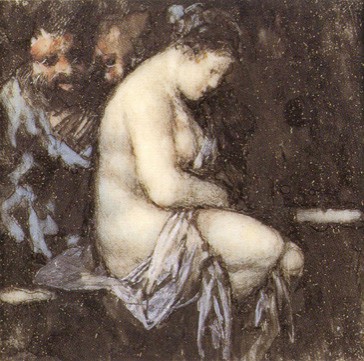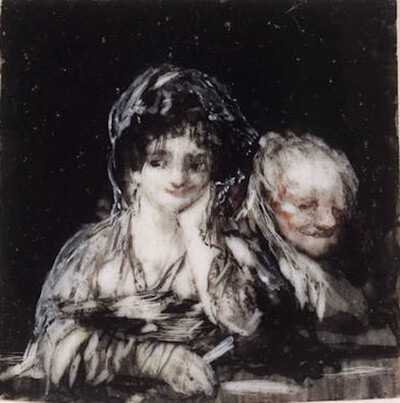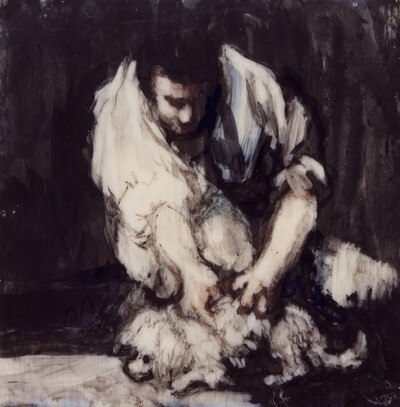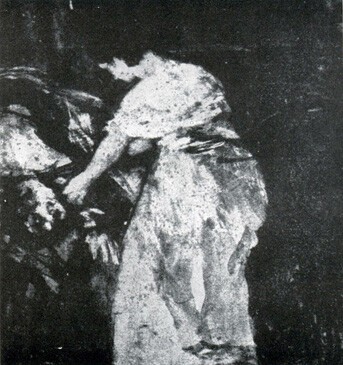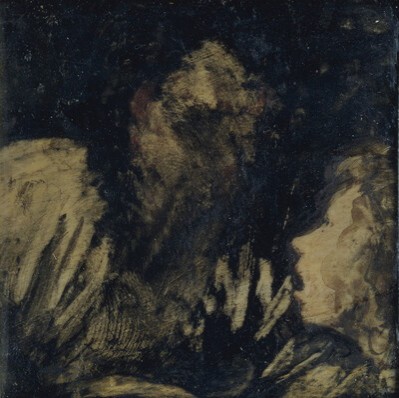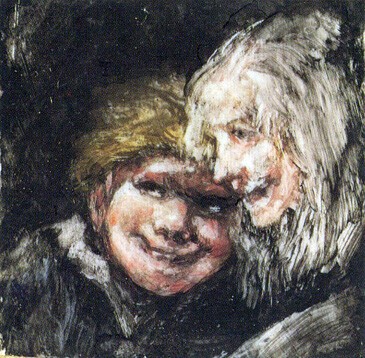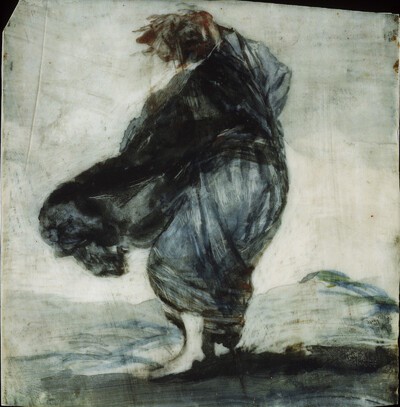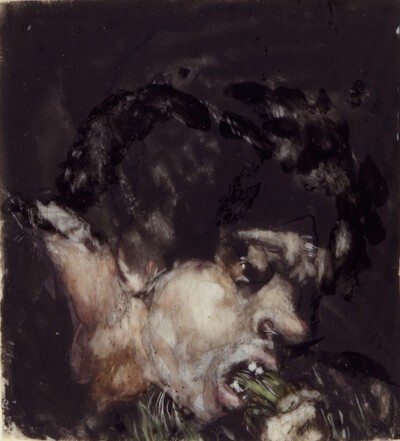- Cronología
- 1824 - 1825
- Ubicación
- Private collection
- Dimensiones
- 5.5 x 5.5 cm
- Técnica y soporte
- Watercolor on ivory
- Reconocimiento de la autoría de Goya
- Undisputed work
- Titular
- Private collection
- Ficha: realización/revisión
- 05 May 2010 / 15 Jun 2023
- Inventario
- -
See Maja and Celestina.
This work was in the collection of Edward Habich, in Cassel. It was put up for auction in Stuttgart in 1899, together with the rest of the miniatures owned by the collector. After the sale it went to form part of a private collection in New York, until 1966, when it entered the collection which currently houses it.
For the artistic and technical analysis of the complete series, see Maja and Celestina.
The Old Testament story of Susanna and the Elders is set in Babylon, to where the Jewish people had been deported. Susanna was the wife of a rich man, Joakim, who often invited Hebrews into his home. One day, when the beautiful Susanna was getting ready to bathe in the garden of her luxurious house and whilst Joakim was away, two of the judges of Israel, both of whom secretly desired the woman, appeared and threatened to accuse her of committing adultery with a young man if she would not sleep with them. She refused to be blackmailed but was judged and condemned to be stoned to death. At this point, Daniel appeared and, after cross-examining the judges, the tables were turned, with the two lecherous old men being put to death in Susanna's place.
Here in Goya's miniature, Joakim's wife is shown almost naked, only partially covering herself with a bluish cloth. She is seated, seen in profile, and her head is lowered in an introverted, thoughtful attitude. She does not seem to be aware of the presence of the two old men, who are staring at her lasciviously from just behind her. The flesh of Susanna's body is ivory white, in contrast with the black background. She is squeezed into the composition and it almost seems as though her lowered head is a consequence of the reduced dimensions of the support, a necessary step to make room for the rest of her body. The elders, with their puffy faces, wear blue tunics and have rosy, flushed faces.
-
Goya and his timesThe Royal Academy of ArtsLondon1963cat. 66cat. 1
-
Goya. El Capricho y la Invención. Cuadros de gabinete, bocetos y miniaturasMuseo Nacional del PradoMadrid1993from November 18th 1993 to February 15th 1994. Exhibited also at the Royal Academy of Arts, London, March 18th to June 12th 1994 and The Art Institute of Chicago, Chicago, July 16th to October 16th 1994, consultant editors Manuela B. Mena Marqués and Juliet Wilson-Bareaucat. 99
-
Goya. La imagen de la mujerMuseo Nacional del PradoMadrid2001from October 30th 2001 to February 10th 2002. Exhibitied also at the National Gallery of Art, Washington, March 10th to June 2nd 2002, consultant editor Francisco Calvo Serrallercat. 59
-
Goya’s Bordeaux miniatures, , , Boston, 1966Museum of Fine Arts Boston Bulletin1966p. 116, cat. 10
-
Vie et ouvre de Francisco de GoyaParísOffice du livre1970p. 362, cat. 1682
-
BarcelonaPolígrafa1970vol. I, p. 386, cat. 746
-
L’opera pittorica completa di GoyaMilanRizzoli1974p. 136, cat. 673
-
Francisco de Goya, 4 vols.ZaragozaCaja de Ahorros de Zaragoza, Aragón y Rioja1980-1982vol. IV, p. 219
-
Goya. El capricho y la invención. Cuadros de gabinete, bocetos y miniaturasMadridMuseo del Prado1993pp. 324-325, 380, cat. 99 y p. 325 (il.)
-
Goya, la imagen de la mujerMadridMuseo Nacional del Prado y Fundación Amigos del Museo del Prado2001p. 238, cat. 59 y p. 239 (il.)
